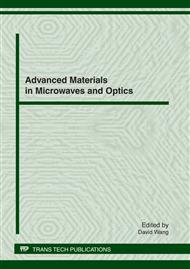p.80
p.84
p.90
p.94
p.98
p.104
p.108
p.114
p.118
Influence of F/P on Structure and Thermal Property of Phenolic Resin
Abstract:
The influence of F/P on structure and thermal property of resin was studied. Six resins were synthesized with different molar ratios of F/P. These resins were cured by means of temperature and without catalyst. The characterization of the resin was done by Fourier transform infrared spectroscopy (FTIR), thermo gravimetric analysis (TGA) and differential thermo gravimetric analysis (DTG). From the thermal properties of fully cured resins, characteristic properties including pyrolysis temperature and char yield were obtained. A maximum in the benzene ring substitutions, methylene bridge and the result of the thermal properties allow us to say that the resin with F/P molar ratio 1.2 has the highest crosslinking density and highest char yield, over 73%.
Info:
Periodical:
Pages:
98-103
Citation:
Online since:
January 2012
Authors:
Keywords:
Price:
Сopyright:
© 2012 Trans Tech Publications Ltd. All Rights Reserved
Share:
Citation:


